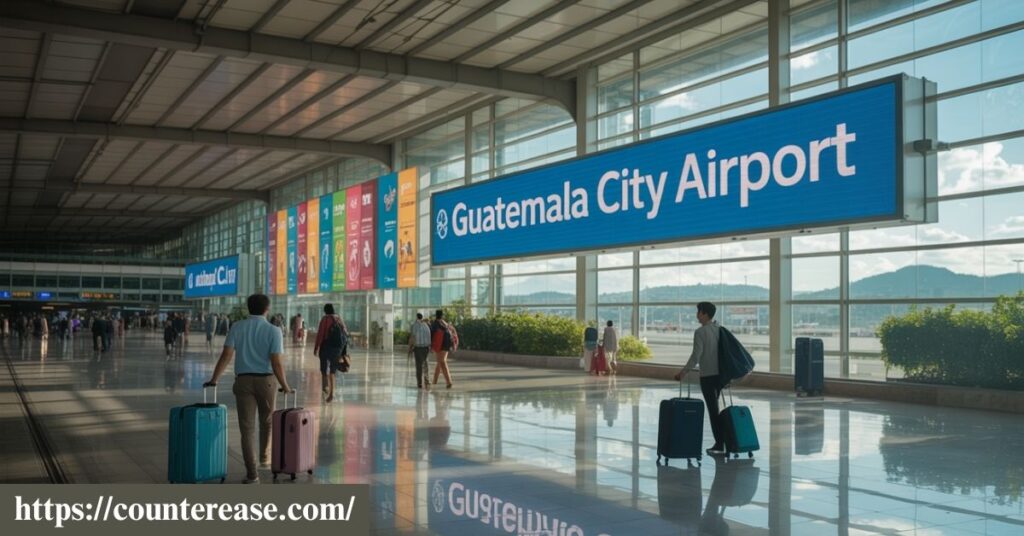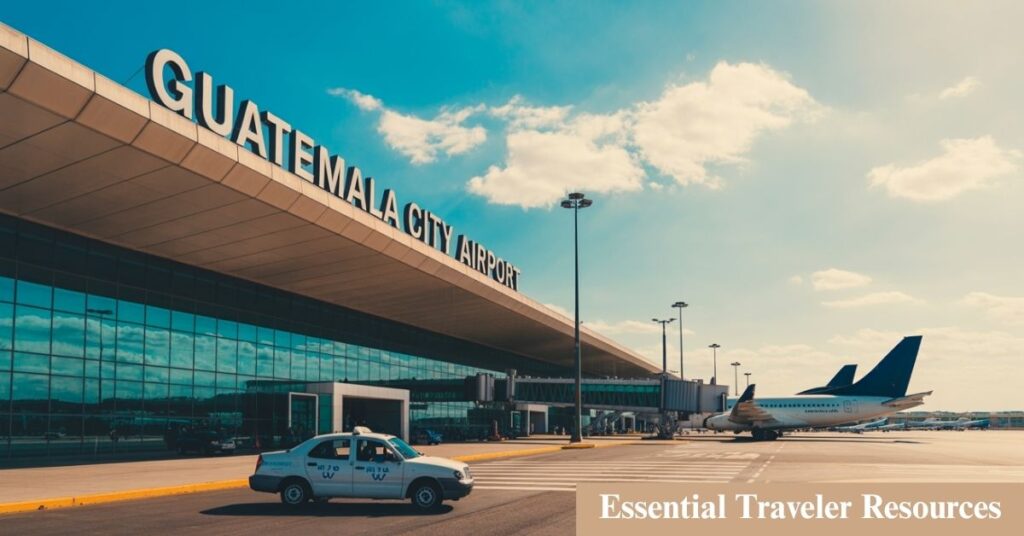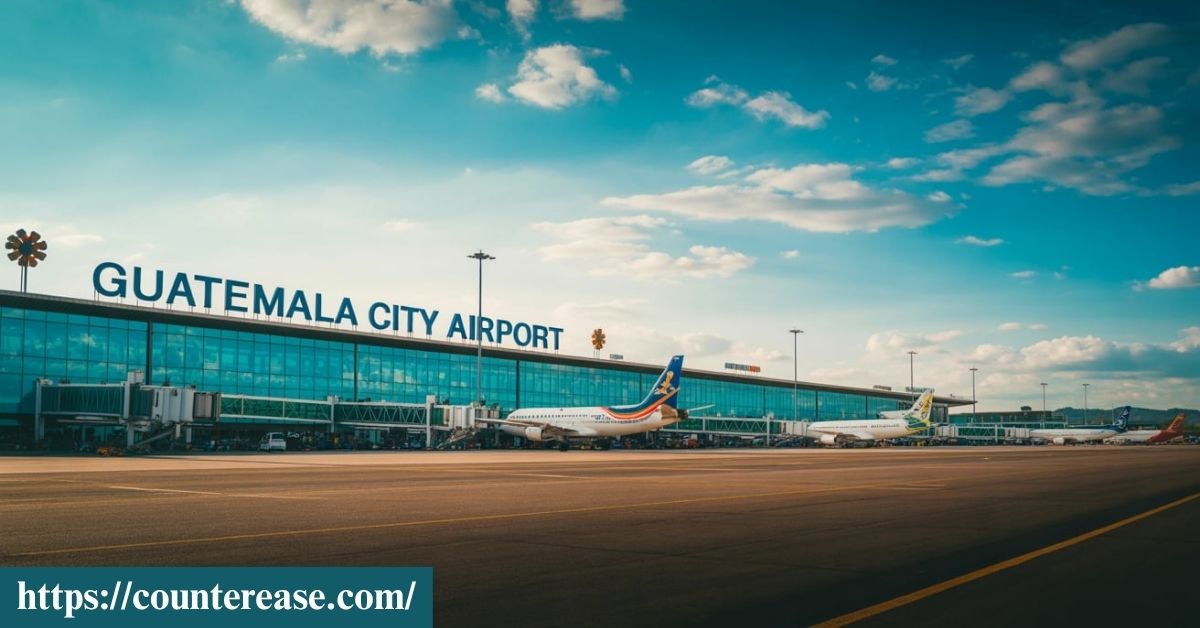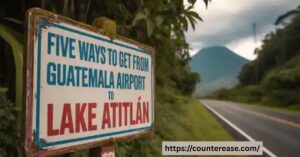Everything about guatemala cit airport refers to the complete experience travelers can expect at La Aurora International Airport (GUA), the main air hub of Guatemala. From modernized terminals and updated runways to lounges, SIM card kiosks, and convenient transport options, this airport serves as the country’s primary gateway. Located in Zona 13 of Guatemala City, everything about guatemala cit airport handles international and domestic flights with growing efficiency and remains a vital part of Central America’s aviation network.
Step inside La Aurora, and you’ll immediately notice its unique blend of function and flair. Unlike massive global airports, everything about guatemala cit airport compact layout ensures you’re never too far from what you need—whether it’s immigration, baggage claim, or a fresh Guatemalan coffee. With panoramic views of the surrounding volcanoes and quick access to city life, this airport gives your journey an unforgettable start or finish.
From arrival procedures to lounges, and from local transport to safety tips, everything about Guatemala City Airport is designed to help travelers feel prepared and confident. This everything about guatemala cit airport highlights essential details, hidden conveniences, and practical insights to make your time at GUA smooth and stress-free—whether you’re landing for an adventure or departing after one.
Your Complete Guide to La Aurora International (GUA)
Stepping off the plane at Guatemala City Airport feels like entering Central America’s beating heart. La Aurora International Airport serves as Guatemala’s primary gateway, welcoming over 2.3 million passengers annually through its modern terminals in Zona 13. Whether you’re connecting to Tikal’s ancient ruins or diving into the capital’s vibrant culture, this compact terminal layout becomes your first Guatemalan experience.

Most travelers wonder about safety, transportation, and basic services before they even book their tickets. This everything about guatemala cit airport cuts through the confusion with real-world insights from frequent flyers and local expertise. You’ll discover everything from ATM machines to official airport taxis, plus insider tips that tourist brochures won’t tell you.
“La Aurora isn’t just an airport—it’s your first taste of Guatemala’s warmth and efficiency. The staff genuinely care about making your arrival smooth.” – Maria Rodriguez, Guatemala Tourism Board
Airport Basics & Strategic Location
La Aurora International Airport sits just 6 kilometers south of Guatemala City’s bustling center, making it remarkably accessible compared to other Central American hubs. The airport occupies a unique position at 4,952 feet above sea level—altitude that affects both aircraft performance and your first breath of Guatemalan air.
Located in Zona 13, the airport neighbors Roosevelt Avenue, one of the city’s main commercial arteries. This everything about guatemala cit airport proximity means you’re never more than 15 minutes from downtown hotels during off-peak hours. The MGGT ICAO code identifies it in aviation circles, while passengers know it simply as GUA.
What makes La Aurora special? It’s the fourth-busiest airport in Central America and Guatemala’s undisputed aviation crown jewel. The facility handles roughly 85% of the country’s international passenger traffic, cementing its role as the primary gateway to Guatemala.
See Also: Review: Thai Airways 777-300 Business Class Hong Kong-Bangkok
Geographic Advantages
The airport’s strategic positioning offers several benefits:
- Close proximity to major hotels (10-20 minutes by taxi)
- Direct highway access via CA-9 Sur
- Multiple transportation options within walking distance
- Central location for exploring Guatemala’s regions
Safety & Security: Real-World Assessment
Airport safety concerns top most travelers’ worry lists, and rightfully so. Guatemala City Airport maintains FAA Category I certification, meaning it meets international safety standards for commercial aviation operations.
“I’ve traveled through La Aurora dozens of times over five years. The security is professional, staff are helpful, and I’ve never felt unsafe inside the terminal.” – James Patterson, Travel Blogger
Airport Security Procedures
Security screening variations depend on your destination. Domestic flights require standard screening, but US-bound flights trigger additional checks. Passengers report secondary screenings that include:
- Enhanced baggage inspection
- Additional document verification
- Liquid restrictions beyond standard TSA rules
- Random pat-downs for certain destinations
The baggage claim area features modern X-ray machines and trained security personnel. Lost & found services operate 24/7 near the main information desk, staffed by bilingual agents who handle roughly 50 cases daily.
Guatemala City Safety Context
The airport vicinity maintains higher security than surrounding neighborhoods. Police patrol regularly, and private security guards monitor parking areas around the clock. However, common sense applies—don’t flash expensive electronics or large amounts of cash.
Transportation safety varies dramatically by option:
| Transport Type | Safety Level | Cost Range | Travel Time | Recommendation |
|---|---|---|---|---|
| Official Airport Taxis | Excellent | Q80-100 ($10-13) | 15-45 mins | Best for first-timers |
| Uber | Excellent | Q50-70 ($6-9) | 12-40 mins | Most economical |
| Hotel Shuttles | Excellent | $15-25 | 20-50 mins | Most convenient |
| Public Buses | Fair | Q2 ($0.25) | 30-90 mins | Budget only |
| Unlicensed Taxis | Poor | Variable | 15-45 mins | Avoid completely |
Time-of-day considerations matter significantly. Daylight hours (6 AM – 6 PM) offer the safest travel window, while late-night arrivals require extra caution.
Essential Services & Modern Amenities
Technology & Communication
Free Wi-Fi blankets both arrivals and departures areas, though connection quality varies by location. The network name “Aurora_Free” requires no password and offers unlimited browsing time. Premium internet costs $5 USD per hour for faster speeds.
SIM card kiosks from Claro and Tigo operate near baggage claim. Claro offers better rural coverage, while Tigo provides faster urban data speeds. Tourist packages start at 150 quetzales ($20 USD) for 30 days of service.
“Getting a local SIM card at the airport saved me hundreds in roaming charges. The Claro booth staff spoke perfect English and had me connected in five minutes.” – Sarah Chen, Digital Nomad
| Provider | Coverage | Data Speed | Tourist Package | Best For |
|---|---|---|---|---|
| Claro | Excellent rural | Moderate | 30GB/30 days – Q150 | Countrywide travel |
| Tigo | Good rural | Fast urban | 25GB/30 days – Q140 | City-focused trips |
Charging stations dot the terminal at regular intervals. Universal outlets accommodate most plug types, though bringing an adapter ensures compatibility.
Money & Banking Solutions
ATM machines in both arrivals and departures areas dispense quetzales and US dollars. BAC Credomatic ATMs charge the lowest fees (around Q15 per transaction), while international banks may charge $3-5 USD plus conversion fees.
Currency exchange booths offer convenience but terrible rates—typically 10-15% below market value. Smart travelers use ATMs instead. The airport’s overpriced exchange rates consistently rank among Central America’s worst deals.
Credit card acceptance varies widely. Major terminals accept Visa and Mastercard, but smaller vendors prefer cash. American Express works sporadically.
Food & Dining Landscape
Arrival area options include limited snack bars and one sit-down restaurant. Pollo Campero represents Guatemala’s most famous fast-food export, serving crispy chicken that locals swear beats KFC. Hours: 5 AM – 11 PM daily.
Departure dining expands dramatically with multiple restaurants, cafes, and bars. Prices run 200-300% higher than city restaurants, but quality remains acceptable.
Local vs international cuisine splits roughly 60/40. Traditional options include:
- Pepián (spiced meat stew) – Q85
- Chiles rellenos (stuffed peppers) – Q65
- Tamales (corn masa wraps) – Q45
- Fresh tropical fruit juices – Q25
Operating hours vary, but core restaurants stay open 18+ hours daily. Late-night options cluster around Gate 10-12 for red-eye flights.
See Also: Review: Alaska Airlines Lounge New York JFK
Transportation Hub: Getting Around
City Center Connections
Bus routes offer the cheapest option but require local knowledge and Spanish skills. Route 83 connects the airport to downtown for Q2 (about $0.25 USD), but chicken buses can feel overwhelming for first-time visitors.
Official airport taxis use standardized pricing: Q80-100 ($10-13 USD) to Zone 1 (historic center), Q60-80 to Zone 10 (hotel district). Licensed taxis display clear identification and use meters.
Uber operates legally and safely from designated pickup zones. Rides cost Q50-70 to central areas, roughly 30% less than traditional taxis. The app works in English and accepts credit cards.
Hotel shuttles serve major properties like Real InterContinental, Marriott, and Holiday Inn. Many boutique hotels arrange private transfers for $15-25 USD.
“The Uber pickup process is seamless. Walk to Level 1, follow the signs to ‘Ride Share,’ and your driver will find you within minutes. Much easier than haggling with taxi drivers.” – Roberto Martinez, Business Traveler
Distance & Travel Time Reality
Peak vs off-peak dramatically affects travel times:
| Destination | Off-Peak | Peak Hours | Distance | Best Times |
|---|---|---|---|---|
| Zone 1 (Centro) | 15 minutes | 45 minutes | 8 km | 10AM-4PM, 8PM-6AM |
| Zone 10 (Hotels) | 12 minutes | 35 minutes | 6 km | 10AM-4PM, 8PM-6AM |
| Zone 15 (Shopping) | 18 minutes | 50 minutes | 9 km | 10AM-4PM, 8PM-6AM |
| Antigua | 45 minutes | 90 minutes | 35 km | Early morning |
Weather considerations impact road conditions. Guatemala’s rainy season (May-October) can double travel times during afternoon downpours. Rush hour peaks occur 7-9 AM and 5-7 PM on weekdays.
Airport Infrastructure & Layout
Terminal Organization
The compact terminal layout spans just two levels but handles traffic efficiently. Clear signage in Spanish and English guides passengers through immigration, baggage claim, and customs without confusion.
Size assessment: La Aurora feels intimate compared to major international hubs. Walking from immigration to the farthest gate takes under 10 minutes. This efficiency compensates for limited amenities.
Accessibility features include elevators, wheelchair-accessible restrooms, and dedicated parking spaces. Staff assistance is available for passengers with mobility challenges.
The 2008-09 glass concourse expansion modernized passenger areas significantly. Runway repaving projects in recent years improved aircraft operations and reduced delays.

Lounge Access & Premium Services
Copa Club, Casa del Ron, and BAC Lounge serve premium passengers and frequent flyers. Copa Club offers the best amenities, including complimentary food, premium alcohol, and shower facilities.
| Lounge | Access Fee | Hours | Best Features | Capacity |
|---|---|---|---|---|
| Copa Club | $45 USD | 5AM-11PM | Showers, hot meals | 80 guests |
| Casa del Ron | $35 USD | 6AM-10PM | Premium rum bar | 60 guests |
| BAC Lounge | $30 USD | 5AM-11PM | Business center | 40 guests |
Operational Excellence
Airlines served include major Central American carriers plus international connections:
Major Airlines:
- Avianca (regional hub)
- Copa Airlines (Panama connections)
- American Airlines (Miami, Dallas)
- United (Houston, Newark)
- Volaris (Mexico routes)
Route network connects Guatemala to 25+ international destinations. Morning departures dominate US routes, while afternoon flights serve Central America.
Entry Requirements & Immigration
Immigration Essentials
Document requirements remain straightforward for most visitors. US citizens need passports valid for six months beyond their planned departure. Tourist visas aren’t required for stays under 90 days.
Onward travel proof isn’t consistently enforced, but immigration officers may ask business travelers or young backpackers to show return tickets. Airlines check this requirement more strictly than immigration.
Processing times vary wildly. Peak season (December-April) and holiday periods can create 45-minute waits. Off-season immigration takes 10-15 minutes typically.
“Immigration was surprisingly quick—maybe 8 minutes total. The officer spoke English, stamped my passport, and welcomed me to Guatemala. Very professional experience.” – Lisa Thompson, Tourist
Customs Procedures
Baggage inspection follows the “nothing to declare” model familiar to international travelers. Random screening affects roughly 10% of passengers, focusing on electronics and expensive goods.
Prohibited items include fresh fruits, meat products, and undeclared amounts over $500 USD. Agricultural restrictions prohibit most food items from entering Guatemala.
Duty-free allowances permit:
- 2 liters of alcohol per adult
- 200 cigarettes or equivalent tobacco
- Personal electronics under $500 value
Guatemala’s Aviation Network
National Context
Guatemala operates 16 airports total, but only La Aurora handles significant international traffic. Regional airports in Flores (FRS) and Puerto Barrios serve domestic routes and limited international charters.
La Aurora’s dominance shows in passenger statistics: 2.3 million annual passengers versus roughly 200,000 combined at all other Guatemalan airports. This everything about guatemala cit airport concentration makes GUA unavoidable for most international visitors.
Alternative airports make sense only for specific destinations. Flores serves Tikal-bound tourists, while Puerto Barrios connects to Caribbean coast resorts.
Regional Importance
As a mixed public, general aviation and military airport, La Aurora serves multiple functions. Military operations occupy separate areas, while general aviation handles private jets and cargo flights.
The airport’s role as Central America’s fourth-busiest hub stems from Guatemala’s geographic position and economic importance.
See Also: Best Beer In Nicaragua?
Frequently Asked Questions
1. Is Guatemala City Airport safe for travelers?
Yes, La Aurora International Airport maintains high security standards with FAA Category I certification. The terminal features 24/7 security, regular police patrols, and modern screening equipment. Stay alert but don’t worry excessively.
2. How much does transportation cost from the airport?
Official airport taxis charge Q80-100 ($10-13) to central zones. Uber costs Q50-70 ($6-9) for the same routes. Hotel shuttles range from $15-25 but offer door-to-door convenience.
3. Is there free Wi-Fi at Guatemala City Airport?
Yes, connect to “Aurora_Free” network in both arrivals and departures areas. No password required, unlimited time, though speeds vary by location. Premium Wi-Fi costs $5/hour for faster connectivity.
4. Can I buy a SIM card at the airport?
Claro and Tigo operate SIM card kiosks near baggage claim. Tourist packages start at Q150 ($20) for 30 days. Staff speak English and can help with setup.
5. What food options are available?
Departure areas offer multiple restaurants, cafes, and bars. Arrival areas have limited options, mainly Pollo Campero and snack bars. Expect airport prices (200-300% higher than city restaurants).
6. How early should I arrive for flights?
International flights: 2-3 hours early Domestic flights: 1-2 hours early US-bound flights: 3 hours (additional screening required)
7. Are there ATMs in the airport?
Yes, ATM machines in both arrivals and departures dispense quetzales and US dollars. BAC Credomatic charges lowest fees (Q15 per transaction). Avoid currency exchange booths due to poor rates.
8. What’s the airport code for Guatemala City?
GUA (IATA code) or MGGT (ICAO code). Use GUA when booking flights or arranging transportation.
Essential Traveler Resources

Communication Tips
Staff speak basic English in tourist areas, but Spanish helps significantly. Key phrases include:
- “¿Dónde está…?” (Where is…?)
- “¿Cuánto cuesta?” (How much does it cost?)
- “No hablo español” (I don’t speak Spanish)
Cultural Considerations
Guatemalans appreciate polite greetings. “Buenos días” (good morning) or “buenas tardes” (good afternoon) open interactions positively. Tipping isn’t mandatory but 10% is appreciated for good service.
Security recommendations emphasize common sense over paranoia. Keep valuables secure, avoid displaying expensive items, and stick to well-traveled areas.
Emergency Contacts
- Airport Information: +502 2331-4720
- Tourist Police: +502 2421-2810
- Medical Services: +502 2331-4721
- Immigration Issues: +502 2411-2411
La Aurora International Airport may lack the glamour of major international hubs, but its efficiency and strategic location make it an excellent gateway to Guatemala’s wonders. The compact terminal layout ensures quick transitions, while comprehensive services meet most traveler needs.
Smart preparation beats last-minute scrambling. Download offline maps, exchange some currency beforehand, and research your transportation options. Whether you’re heading to Antigua’s cobblestone streets or Tikal’s towering pyramids, your Guatemalan adventure begins the moment you step into GUA’s modern terminals.
“La Aurora surprised me with its efficiency and friendliness. It’s not the biggest airport, but everything works smoothly. The perfect introduction to Guatemala’s organized chaos.” – David Wilson, Photographer
Remember that airport facilities continue improving through ongoing modernization projects. The fourth-busiest Central American airport keeps evolving to serve growing passenger demand while maintaining its reputation as Guatemala’s reliable aviation gateway.
Conclusion
In short, everything-about-guatemala-city-airport shows how important and useful La Aurora International Airport is for travelers. It offers clean facilities, clear signs, and helpful staff. The airport is not too big, which makes everything about guatemala cit airport easy to find your way. Services like free Wi-Fi, SIM card kiosks, and nearby hotels make your trip smoother and more comfortable.
Whether you’re visiting for the first time or coming back to Guatemala, knowing everything-about-guatemala-city-airport helps you feel ready. You’ll understand what to expect from arrival to departure. From safe taxi options to airport lounges, this guide gives you the key details. With this information, you can enjoy your travel with less stress and more confidence.

Asia Jenni is a passionate travel writer and expert author on CounterEase.com. With a deep love for exploration, she shares insightful travel guides, tips, and destination recommendations, helping travelers discover new places with ease. Her expertise in curating memorable trips and her engaging writing style make her a valuable resource for anyone looking to plan their next adventure.








